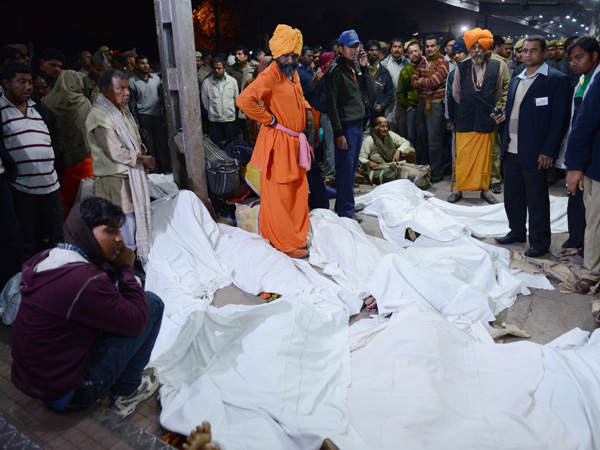22 reported dead as stampede mars India’s Ganges festival

Indian authorities stand among some of the travellers that were killed during a stampede at the railway station in Allahabad, on February 10, 2013. AFP/ ROBERTO SCHMIDT
Allahabad, India – At least 22 people died in a stampede as pilgrims headed home from India’s giant Kumbh Mela festival, which drew a record 30 million people to the banks of the river Ganges, reports said Monday.
Senior railway official Harindra Rao said 10 people had died at Allahabad station during the stampede on Sunday, with 12 more succumbing to their injuries on the way to hospital, the Press Trust of India (PTI) news agency reported early Monday.
Rao, who is divisional railway manager of Allahabad, said that more than 20 others who were injured were undergoing treatment at two hospitals in the city, with 15 of them in critical condition, according to PTI.
Local television channel NDTV also reported that 22 people had died.
The incident occurred in the early evening at the festival’s main railway station, where 10 corpses wrapped in white sheets could be seen on a train platform several hours later, an AFP photographer said.
Article continues after this advertisementDozens more were injured in the crush, which marked a tragic end to the most auspicious day of the 55-day festival in northern India.
Article continues after this advertisementLocal officials said that the railings on a bridge at the station had given way under the pressure of the mass of people, while eyewitnesses told local media that the police had baton-charged the crowd.
“People were taking rest on these railings and the railings could not take the load. The joints broke,” a spokesman for the local Uttar Pradesh state, Ashok Sharma, told AFP.
Railways Minister Pawan Kumar Bansal denied that this had been the cause, PTI reported, saying that overcrowding on the platforms may have led to the stampede.
Relatives of the victims blamed police for causing the panic which led to the accident, while others said emergency services took hours to reach the scene to help the injured.
“My sister is lying here unattended to for the last two hours. Why is no-one coming?” a woman from the impoverished state of Bihar told the NDTV channel from the platform as her sister lay immobile and with eyes half-shut next to her.
Indian Prime Minister Manmohan Singh issued a statement saying that he was “deeply shocked to learn of the unfortunate incident” while Bansal said he would travel to Allahabad to investigate.
The tragedy came at the end of a day which organisers had earlier declared a success after a record number had taken a bath in the holy waters of the Ganges, which is said to cleanse pilgrims of their sins.
“By afternoon over two crore (20 million) people had taken the holy dip and by evening the numbers crossed three crore (30 million),” top local official Devesh Chaturvedi told a press conference.
Police had been stretched in controlling the vast crowds, he admitted, and one person had died for unknown reasons, while another later succumbed to injuries sustained in a crush.
The Kumbh Mela, which began last month and ends in March, takes place every 12 years in the northern city of Allahabad. Smaller, similar events are held every three years in other locations around India.
In 2003, 45 people died in a stampede during the festival in the western Indian town of Nasik.
Crushes are a constant and frequently deadly risk at religious events in India, where policing and crowd control are often inadequate.
The worst recent incident was in October 2008 when around 220 people died near a temple inside a famous fort in the northern city of Jodhpur.
At the Kumbh Mela on Sunday, 30,000 volunteers and 7,000 police were on duty, urging pilgrims to take one short bath and then leave the waters to make space for the flow of humanity which stretched for kilometres (miles).
This year’s Mela is big even by previous standards, with astrologers saying a planetary alignment seen once every 147 years made it particularly auspicious for some pilgrims.
The Kumbh Mela has its origins in Hindu mythology, which describes how a few drops of the nectar of immortality fell on the four places that host the festival — Allahabad, Nasik, Ujjain and Haridwar.